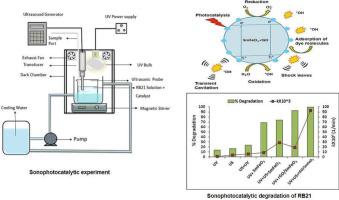Journal of Water Process Engineering ( IF 6.3 ) Pub Date : 2023-09-25 , DOI: 10.1016/j.jwpe.2023.104314 Jyoti Katiyar , Virendra Kumar Saharan

|
This research aimed to synthesize SmFeO3 and SmFeO3-rGO photocatalysts via an ultrasound-assisted sol-gel technique. The synthesized photocatalysts were characterized through various analytical technique including XPS, XRD, FESEM with EDX, FTIR, PL, UV-DRS LC-MS, Mott Schottky Plot, and BET analysis. The study evaluated the photocatalytic degradation efficiency of Reactive Blue 21 (RB21) using these synthesized photocatalysts, and the influence of operating factors such as solution pH, catalyst dose, and initial dye concentration. In order to enhance the activity of the photocatalyst, a combination of ultrasonication (US) and ultraviolet (UV) irradiation, were used, and their respective results have been reported in the present study. The RB21 degradation followed first-order kinetics, achieving a rate constant of 8.7 × 10−3 min−1. Over 68.82 % degradation was noted under optimal conditions, utilizing 20 mg/L SmFeO3 catalyst at a pH of 7.1. Using SmFeO3-rGO with an optimal molar ratio of rGO to SmFeO3 (1:1) achieved over 92.37 % degradation in 120 min. However, the sonophotocatalytic approach resulted in 99.41 % degradation within 30 min. The mineralization of textile dyeing effluents using sonophotocatalytic method observed significant COD and TOC reductions of 78.3 % and 75.9 % respectively in 30 min treatment. The SmFeO3-rGO nanophotocatalyst exhibited reliable degradation performance across five cycles. The LC-MS analysis provides a detailed view into the degradation pathway of RB21 through sonophotocatalysis. The combined ultrasonication and photocatalytic oxidation strategy yielded superior energy efficiency (4.45 × 10−6 mg/J) as compared to UV, US, and UV + SmFeO3-rGO methods.
中文翻译:

合成 SmFeO3-rGO 光催化剂结合超声处理增强光催化降解活性蓝 21 染料和纺织印染废水:表征和性能评估
本研究旨在合成SmFeO 3和SmFeO 3-rGO 光催化剂通过超声波辅助溶胶凝胶技术。通过各种分析技术对合成的光催化剂进行了表征,包括 XPS、XRD、FESEM with EDX、FTIR、PL、UV-DRS LC-MS、Mott Schottky Plot 和 BET 分析。该研究评估了使用这些合成光催化剂的活性蓝21(RB21)的光催化降解效率,以及溶液pH、催化剂剂量和初始染料浓度等操作因素的影响。为了增强光催化剂的活性,结合使用了超声波(US)和紫外线(UV)照射,本研究报告了它们各自的结果。RB21 降解遵循一级动力学,速率常数达到 8.7 × 10 -3 min -1。在最佳条件下,使用 20 mg/L SmFeO 3催化剂,pH 值为 7.1,降解率超过 68.82%。使用具有最佳 rGO 与SmFeO 3 (1:1)摩尔比的 SmFeO 3 -rGO 在 120 分钟内实现了超过 92.37% 的降解。然而,声光催化方法在 30 分钟内降解了 99.41%。使用声光催化方法矿化纺织印染废水,在 30 分钟处理后观察到 COD 和 TOC 分别显着降低 78.3% 和 75.9%。钐铁氧3-rGO纳米光催化剂在五个循环中表现出可靠的降解性能。LC-MS 分析提供了 RB21 通过声光催化降解途径的详细视图。与UV、US和UV + SmFeO 3 -rGO方法相比,超声处理和光催化氧化相结合的策略产生了优异的能量效率(4.45 × 10 -6 mg /J)。







































 京公网安备 11010802027423号
京公网安备 11010802027423号